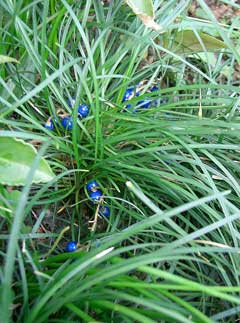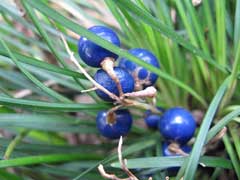 |
|
http://commons.wikimedia.org/wiki/User:KENPEI |
 |
| http://commons.wikimedia.org/wiki/User:KENPEI |
Translate this page:
Summary
Bloom Color: White. Main Bloom Time: Early summer, Late summer, Mid summer. Form: Rounded, Spreading or horizontal.
Physical Characteristics

 Ophiopogon japonicus is an evergreen Perennial growing to 0.3 m (1ft) by 1 m (3ft 3in) at a slow rate.
Ophiopogon japonicus is an evergreen Perennial growing to 0.3 m (1ft) by 1 m (3ft 3in) at a slow rate.
See above for USDA hardiness. It is hardy to UK zone 7. It is in leaf all year, in flower in August, and the seeds ripen from September to October. The species is hermaphrodite (has both male and female organs).
Suitable for: light (sandy) and medium (loamy) soils. Suitable pH: mildly acid, neutral and basic (mildly alkaline) soils. It can grow in semi-shade (light woodland) or no shade. It prefers moist or wet soil and can grow in water.
UK Hardiness Map
US Hardiness Map
Synonyms
Plant Habitats
Woodland Garden Sunny Edge; Dappled Shade; Ground Cover; Pond; Bog Garden;
Edible Uses
Edible Parts: Root
Edible Uses:
Root[61]. A bitterness should be removed according to some reports[105, 177] whilst another says that it is sweet and aromatic[178]. Mucilaginous[179, 218]. The root contains about 1.6% protein, 0.5% fat, 80% carbohydrate, 2.3% ash[179].
References More on Edible Uses
Medicinal Uses
Plants For A Future can not take any responsibility for any adverse effects from the use of plants. Always seek advice from a professional before using a plant medicinally.
Antipyretic Antiscrophulatic Antitussive Aphrodisiac Cancer Emollient Expectorant Nutritive
Pectoral Sedative Sialagogue Stomachic Tonic
The root is antitussive, aphrodisiac, expectorant, pectoral, sedative, sialogogue, stomachic and tonic[147, 174, 176, 218, 238]. It is said to have anticancer activity[218]. It is used internally in the treatment of dry coughs, fevers, thirst, dry constipation, insomnia, anxiety and palpitations[238]. It is also frequently used in polyherbal treatments of diabetes mellitus[218]. The roots have an antibacterial action, inhibiting the growth of Staphylococcus, E. coli, Bacillus subtilis, B. typhi etc[176]. The roots are harvested in the spring and dried for later use[238]. The plant is antipyretic, antiscrofulatic, antitussive, emollient, expectorant and tonic[218]. Lowers blood pressure[176]. Nodules on the fibrous roots are used as a nutritive tonic in the treatment of TB[174].
References More on Medicinal Uses
The Bookshop: Edible Plant Books
Our Latest books on Perennial Plants For Food Forests and Permaculture Gardens in paperback or digital formats.

Edible Tropical Plants
Food Forest Plants for Hotter Conditions: 250+ Plants For Tropical Food Forests & Permaculture Gardens.
More

Edible Temperate Plants
Plants for Your Food Forest: 500 Plants for Temperate Food Forests & Permaculture Gardens.
More

More Books
PFAF have eight books available in paperback and digital formats. Browse the shop for more information.
Shop Now
Other Uses
Soil stabilization
Landscape Uses: Border, Container, Ground cover, Massing, Rock garden, Seashore, Specimen, Woodland garden. A good carpeting plant[1, 200] that spreads quite freely[208], it is commonly planted as a ground cover or as a low-maintenance grass substitute[187, 208]. It is particularly valuable for preventing soil erosion[200]. Plants should be spaced about 45cm apart each way[208]. Special Features:Not North American native, Invasive, Naturalizing, Inconspicuous flowers or blooms.
Special Uses
Ground cover
References More on Other Uses
Cultivation details
Prefers a sandy soil[1]. Succeeds in any moderately fertile well-drained soil and also as a submerged aquatic plant, though it does not flower in such a situation[200]. Succeeds in a sunny position if the soil remains moist all year round, otherwise it should be grown in semi-shade[200]. Plants may require winter protection according to one report[1], whilst another says that they are hardy to about -20°c[200]. Plants only succeed outdoors in the milder areas of the country[208]. This species is cultivated as a medicinal plant in China[178].
References Carbon Farming Information and Carbon Sequestration Information
Temperature Converter
Type a value in the Celsius field to convert the value to Fahrenheit:
Fahrenheit:
The PFAF Bookshop
Plants For A Future have a number of books available in paperback and digital form. Book titles include Edible Plants, Edible Perennials, Edible Trees,Edible Shrubs, Woodland Gardening, and Temperate Food Forest Plants. Our new book is Food Forest Plants For Hotter Conditions (Tropical and Sub-Tropical).
Shop Now
Plant Propagation
Seed - best sown as soon as it is ripe in a sandy compost in a cold frame[200]. When they are large enough to handle, prick the seedlings out into individual pots and grow them on in the cold frame for at least their first winter. Plant them out into their permanent positions in late spring or early summer, after the last expected frosts. Division in spring[188].
Other Names
If available other names are mentioned here
Native Range
TEMPERATE ASIA: China (Anhui Sheng, Fujian Sheng, Guangdong Sheng, Guangxi Zhuangzu Zizhiqu, Guizhou Sheng, Hebei Sheng, Henan Sheng, Hubei Sheng, Hunan Sheng, Jiangsu Sheng, Jiangxi Sheng, Shaanxi Sheng, Shandong Sheng, Sichuan Sheng, Yunnan Sheng, Zhejiang Sheng), Korea, Japan (Hokkaidô, Honshu, Kyushu, Shikoku), Taiwan TROPICAL ASIA: Philippines (Luzon (Benguet Prov.), Mindanao (Mt. Apo))
Weed Potential
Right plant wrong place. We are currently updating this section.
Please note that a plant may be invasive in one area but may not in your area so it's worth checking.
Conservation Status
IUCN Red List of Threatened Plants Status :

Growth: S = slow M = medium F = fast. Soil: L = light (sandy) M = medium H = heavy (clay). pH: A = acid N = neutral B = basic (alkaline). Shade: F = full shade S = semi-shade N = no shade. Moisture: D = dry M = Moist We = wet Wa = water.
Now available:
Food Forest Plants for Mediterranean Conditions
350+ Perennial Plants For Mediterranean and Drier Food Forests and Permaculture Gardens.
[Paperback and eBook]
This is the third in Plants For A Future's series of plant guides for food forests tailored to
specific climate zones. Following volumes on temperate and tropical ecosystems, this book focuses
on species suited to Mediterranean conditions—regions with hot, dry summers and cool, wet winters,
often facing the added challenge of climate change.
Read More
Expert comment
Author
(L.f.)Ker-Gawl.
Botanical References
58200266
Links / References
For a list of references used on this page please go here
Readers comment
© 2010, Plants For A Future. Plants For A Future is a charitable company limited by guarantee, registered in England and Wales. Charity No. 1057719, Company No. 3204567.